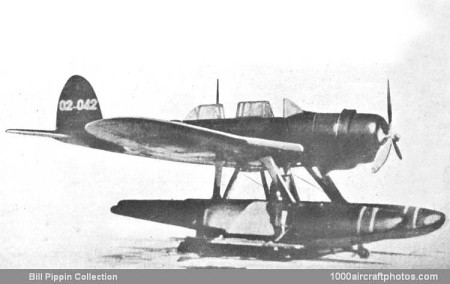In 1937, the Japanese Navy began to evince considerable interest in obtaining a replacement for the ageing Kawanishi E7K2 three-seat twin-float seaplane. In June of that year the Naval Staff issued to Aichi, Nakajima and Kawanishi a 12-Shi (1937) specification calling for a two-seat reconnaissance floatplane. Each of these manufacturers respectively began in September 1937 designing the E12A1, E12N1 and E12K1 but, while all these activities were taking place, another 12-Shi (1937) specification, this time calling for three-seat reconnaissance floatplanes with higher speed and longer range was issued to the same companies. The three additional designs, which complemented rather than supplanted the earlier designs, received the designations E13A1, E13N1 and E13K1.
Of the three competing companies Aichi Tokei Denki K.K.at Funakata was the only one which decided to proceed with the development of two designs to meet the requirements of both specifications while Nakajima decided to concentrate on the two-seater and Kawanishi to build prototypes of a three-seater. The design of the E13A1, drawn up by a design team led by Kishiro Matsuo, bore a strong resemblance to the E12A1, being merely a larger and more powerful version of the two-seat aircraft. Powered by a 1,060 hp Mitsubishi Kinsei 43 fourteen-cylinder air-cooled radial, the first prototype E13A1 was completed in late 1938 almost simultaneously with the two E12A1 prototypes which were powered by 870 hp Mitsubishi Zuisei fourteen-cylinder air-cooled radials.
During manufacturer's trials the E13A1 proved itself to be the best of the two designs since despite its larger size and heavier weight it had better performance and was more stable and maneuverable than the E12A1. Since the Japanese Navy had by then indicated that they favoured a three-seat aircraft, the development of the E12A1 and E12N1 was suspended and the E13A1 was intensively tested by Service pilots in competition with the two prototypes of the Kawanishi E13K1.
In December 1940 the E13A1 won the competition and was accepted for production as the Navy Type 0 Reconnaissance Seaplane Model 1 (later Model 11). Production was initially entrusted to Aichi Tokei Denki K.K. which built, including the prototypes, a total of 133 E13A1s until 1942 when they were instructed to concentrate on producing the D3A and D4Y carrier bombers. At that time the prime responsibility for the production of the Navy Type 0 Reconnaissance Seaplane was entrusted to K.K. Watanabe Tekkosho (later reorganized as Kyushu Hikoki K.K.) while limited production of the aircraft was undertaken by the Dai-Juichi Kaigun Kokusho (11th Naval Air Arsenal) at Hiro.
The E13A1 made its combat debut in late 1941 when, operating from cruisers and seaplane tenders, the aircraft was used for attacks on the Canton-Hankow railway and for anti-shipping patrols. Shortly thereafter E13A1s launched from cruisers of the 8th Cruiser Division (Tone, Chikuma and Kinugasa) flew reconnaissance missions during the Hawaiian operation. From then on Navy Type 0 Reconnaissance Seaplanes operating from ships as well as from shore bases were found wherever the Japanese Navy were active.
Despite its lack of fuel tankage and crew protection and its limited defensive armament, this aircraft was eminently successful and its maximum endurance of almost fifteen hours suited it admirably to long patrol reconnaissance missions. On occasions the E13A1, known to the Allies as Jake, was used for bombing missions whenever Allied air opposition was limited. Other missions performed by the Navy Type 0 Reconnaissance Seaplane included air-sea rescue, staff transport, shipping attack and, late in the war, kamikaze sorties.
For almost four years no model changes were made and when in November 1944 two new versions appeared they could only be distinguished by the fitting of two additional pairs of inward sloping float bracing struts and a propeller spinner. Retaining the Kinsei 43 radial of the initial model, the E13A1a Model 11A was fitted with improved radio equipment while the E13A1b Model 11B was equipped with air-to-surface radar with antennae on the wing leading edges and the rear fuselage sides. For night operations aircraft of each of these versions could be fitted with exhaust flame dampers while for operations against P.T. (Patrol Torpedo) boats a flexible 0.787 in (20 mm) cannon firing from the fuselage belly could be mounted. Some E13A1s were also fitted with a magnetic airborne submarine detection device known as Jikitanchiki but results were poor unless the aircraft flew at a mere 30 to 40 ft (9 to 12 m) above the surface.
Production totaled 1,418 E13A1s, these were built by Aichi (133), Dai-Juichi Kaigun Kokusho at Hiro (48) and Kyushu Hikoki K.K. at Zasshonokuma (1,237).
Description: Single-engined twin-float reconnaissance seaplane. All-metal construction with fabric covered control surfaces.
Accommodation: Crew of three in tandem enclosed cockpits.
Power plant: One Mitsubishi Kinsei 43 fourteen-cylinder air-cooled radial, rated at 1,060 hp for take off and 1,080 hp at 6,560 ft (2,000 m), driving a three-blade metal propeller.
Armament:
External bomb load: one 551 lb (250 kg) bomb, or four l32 lb (60 kg) bombs or depth charges.
Early production E13A1: one flexible rear-firing 0.303 in (7.7 mm) Type 92 machine gun.
Late production E13A1: one flexible rear-firing 0.303 in (7.7 mm) Type 92 machine gun and one flexible downward-firing 0.787 in (20 mm) Type 99 Model 1 cannon.
